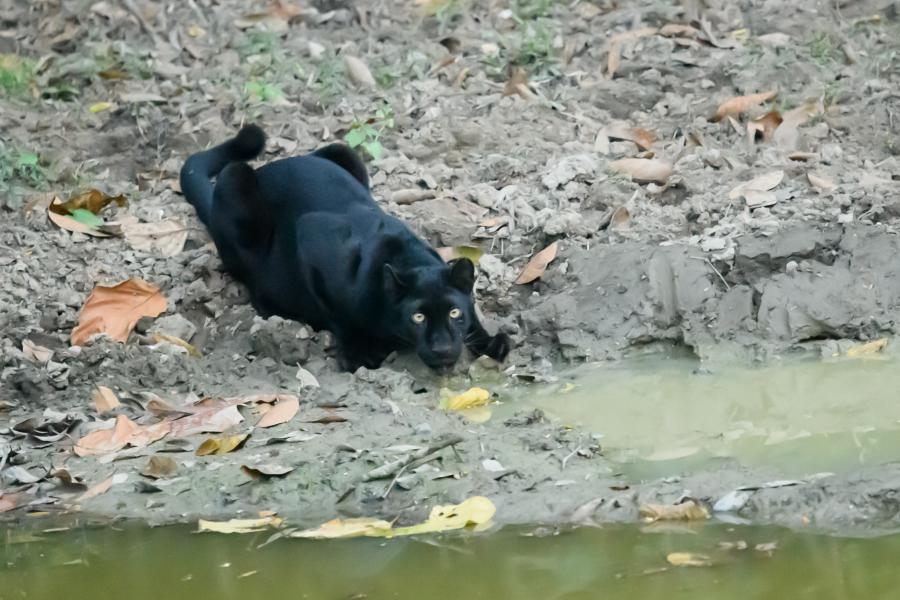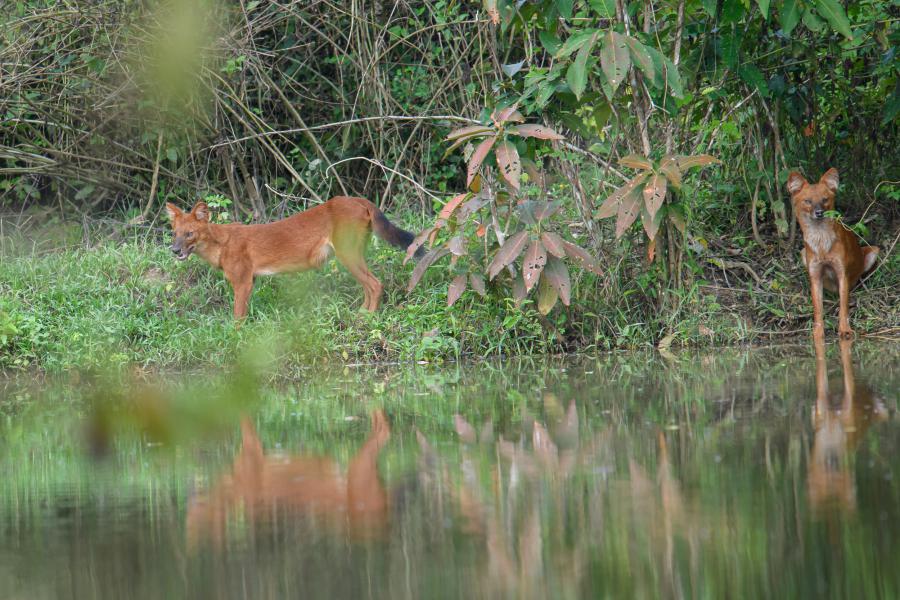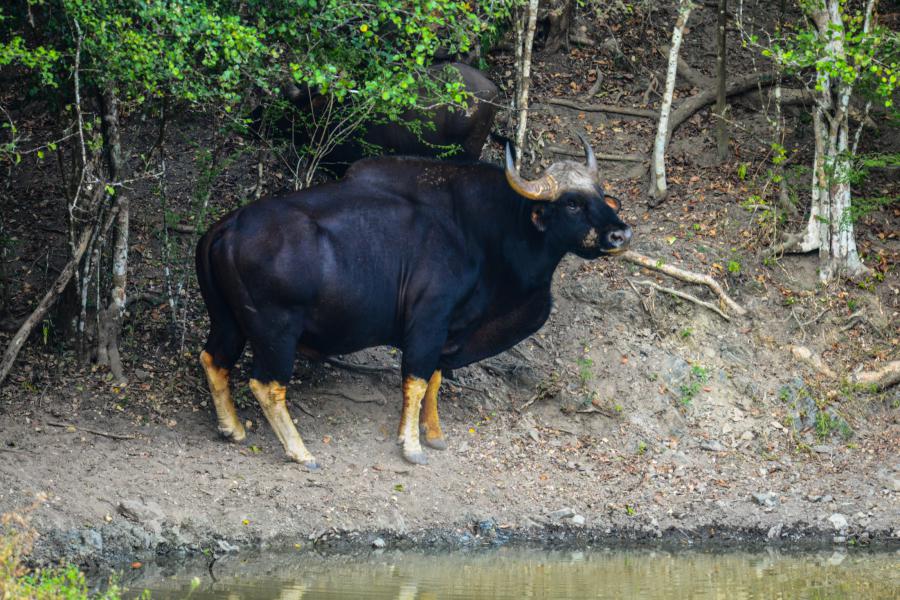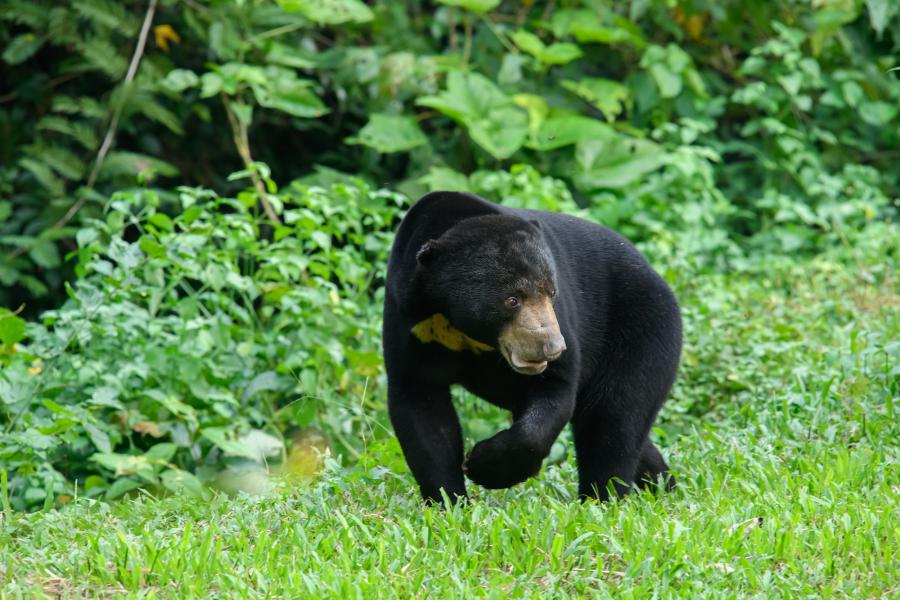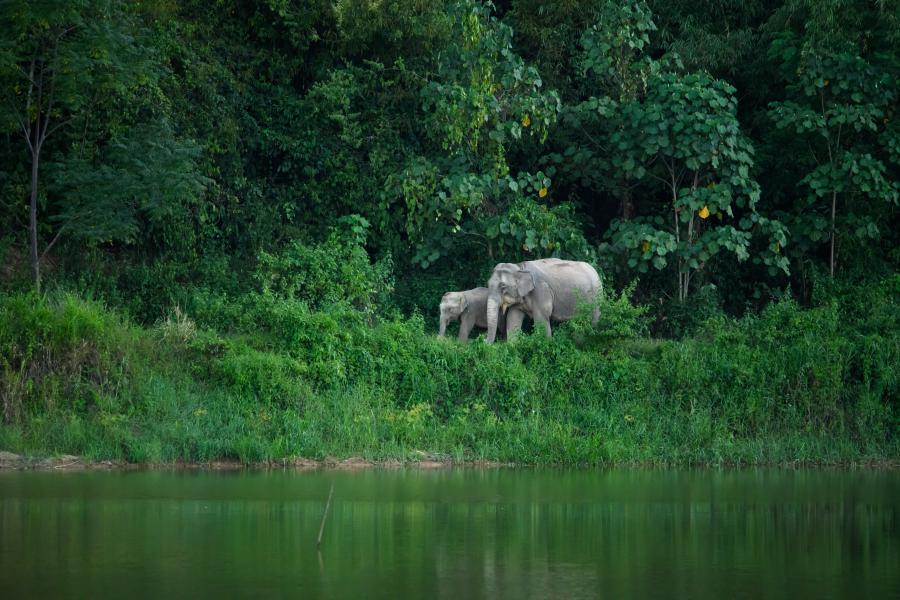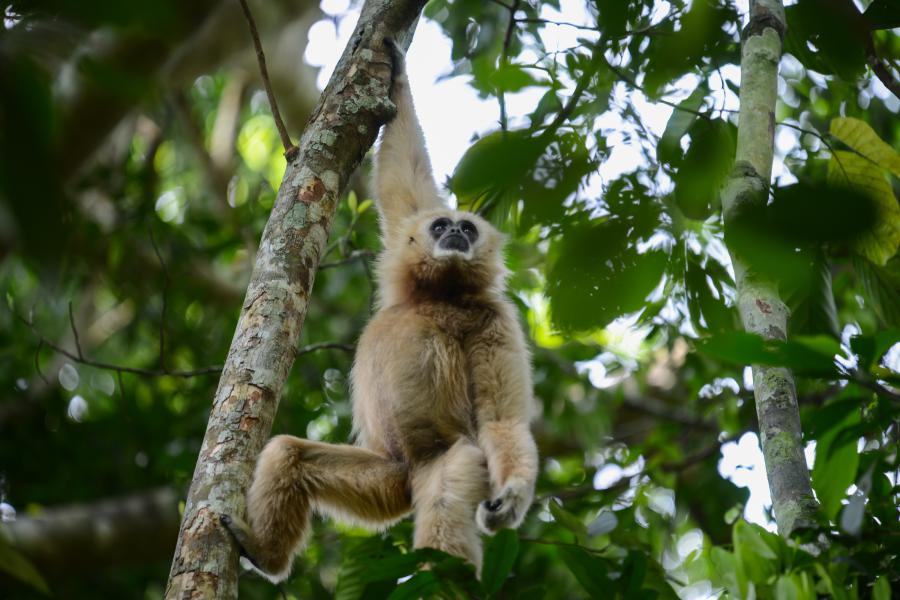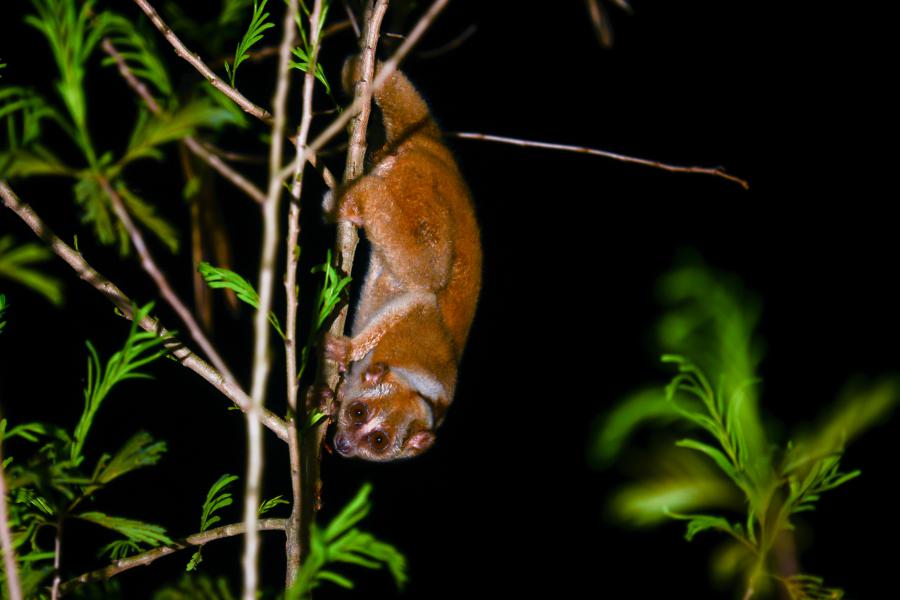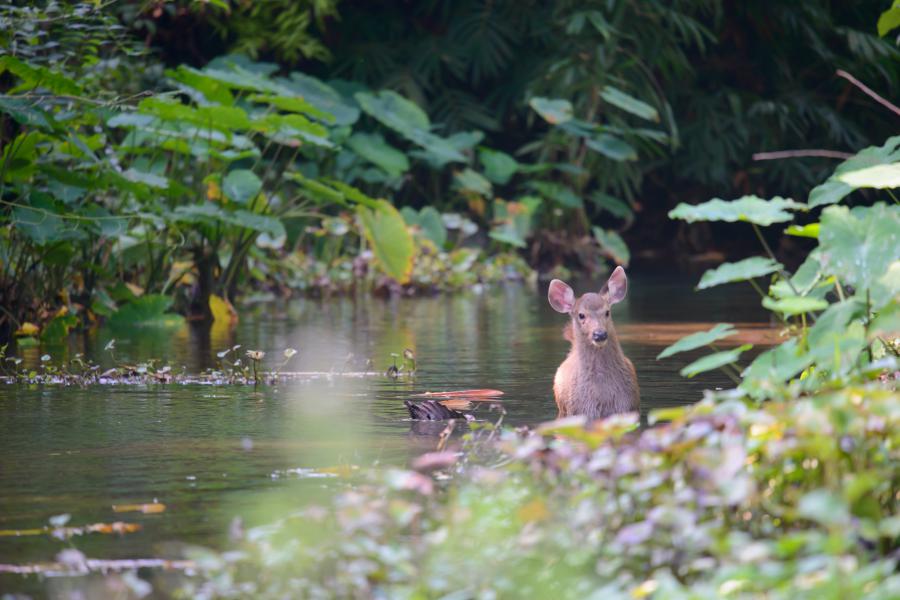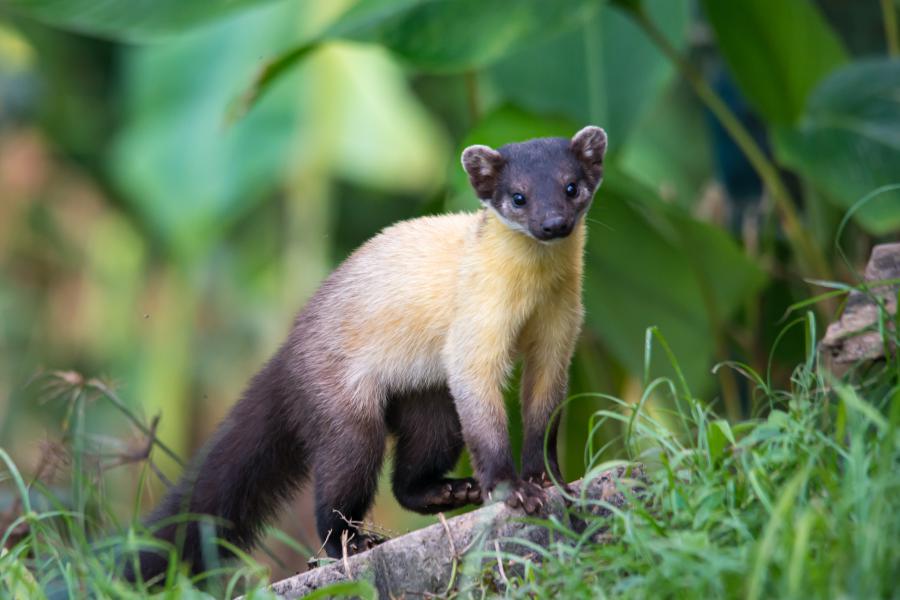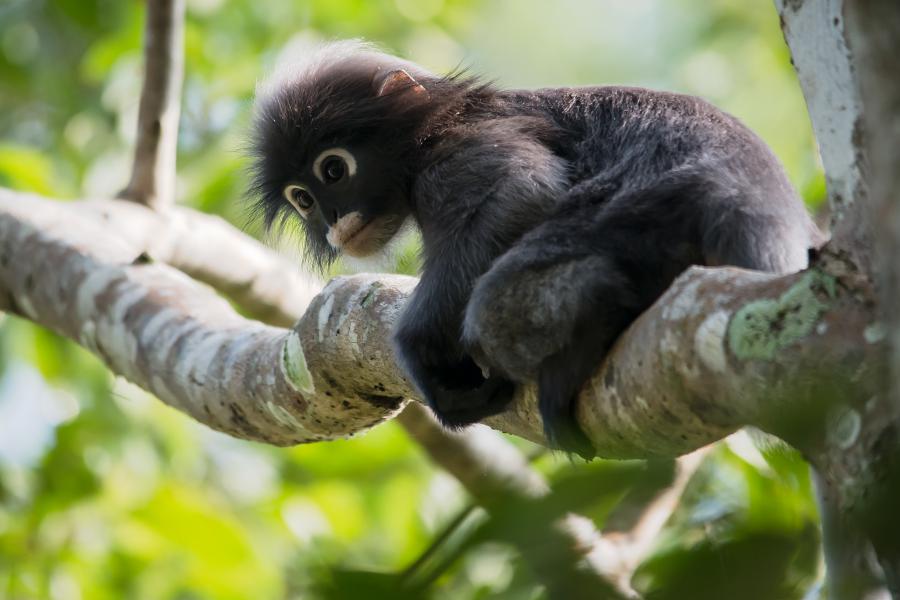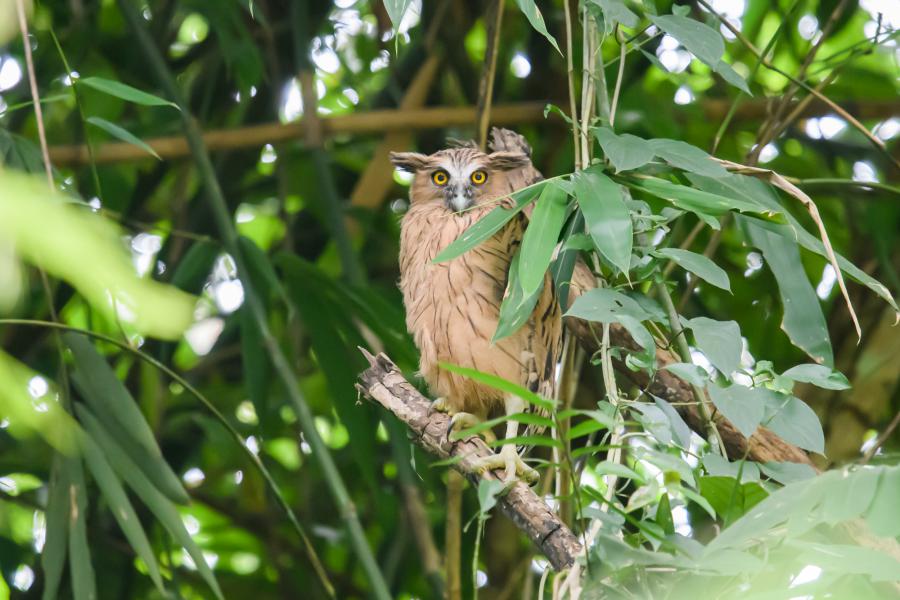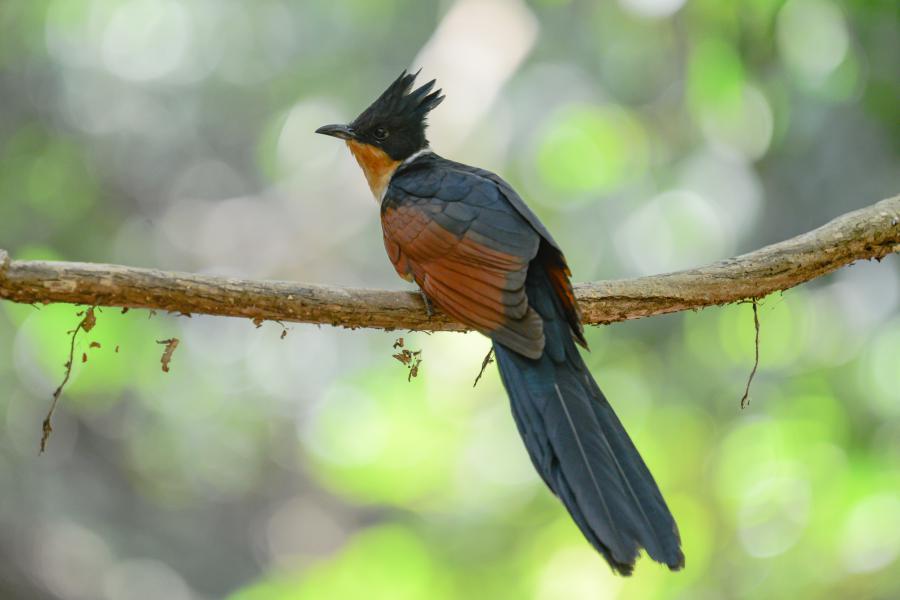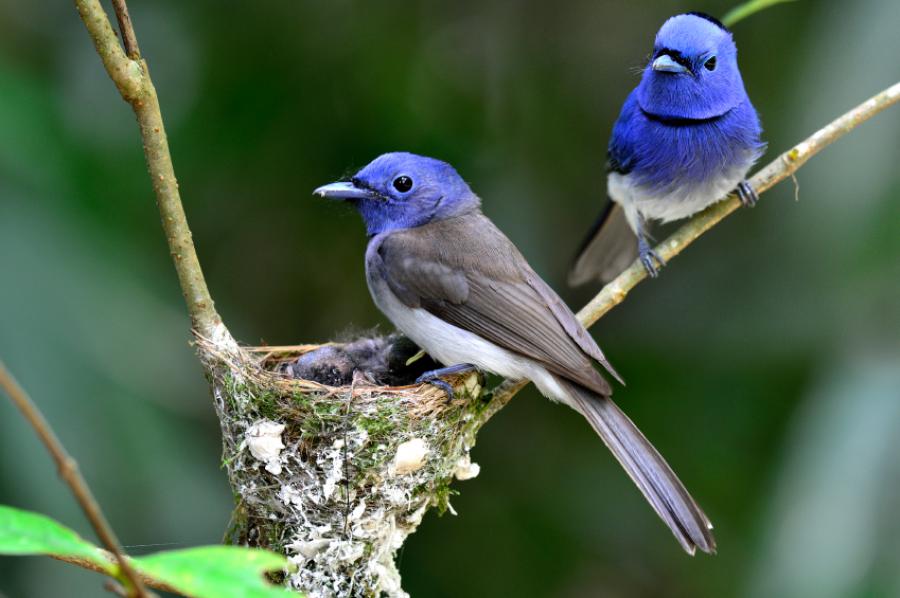About Kaeng Krachan
Kaeng Krachan National Park is located in Phetchaburi and Prachuap Khiri Khan Provinces, about 60 km from Phetchaburi and 75 km from Hua Hin. Covering an area of 2,914 km² it is the largest national park in Thailand. The park is part of the Western Forex Complex that covers 18,730 km² across 19 protected sites between Myanmar and Thailand, bounded by the Tanintharyi Nature Reserve along Myanmar's border to the west.
Declared as a national park on 12th June 1981 and listed as a World Heritage Site in July 2021, Kaeng Krachan National Park is one of the best national parks in the country. Likely no other protected site in the country has such a big variety of animals.
The park is very popular for wildlife watching, camping, hiking and it’s impressive viewpoints for the sea of mist. The park has also a few medium size waterfalls and a couple of smaller caves.
There are two main rivers in the park; Phetchaburi and Pran Buri Rivers. Both rivers originate from the Tanaosri Mountain Range. In the north, Phetchaburi River flows into Kaeng Krachan Dam and flows further east all the way out to the Gulf of Thailand. Pran Buri River flows south to Prachuap Khiri Khan Province, into Pran Buri Reservoir and out to the Gulf of Thailand.
The highest elevation in the park is a peak along the Burmese border at around 1,500 meters asl. The second highest peak is Phanoen Thung Mountain at 1,207 meters asl.
The rainy season is May/June to October with the most rainfall in September to October. November to early February tends to be a bit cooler with a bit cool/chilly temperatures in the night. The dry season is from around February until May.
Wildlife
The park being popular for wildlife watching doesn’t necessarily mean wildlife watching is easy. While birdwatching is easy, a bit more effort is needed to see more of the impressive mammals in the park. Wildlife watching possibilities also vary depending on seasonal conditions in the park.
Mammals
Mammal species such as leopards, clouded leopards, bears, stump-tailed macaques, sambar deer, barking deer, elephants, dholes, golden jackals, gaurs, serows, yellow-throated martens, various civet species, crab-eating mongooses and many others can be found in the park.
There used to be a significant tiger population in the park up until a couple of decades ago, but likely only a very few left. According an announcement made in 2023, there are at least 3 tiger individuals recorded from the park. There are also tapirs in the park, known from camera traps and footprints.
Stump-tailed macaques are the welcoming committee of the animals in the park. While driving towards Ban Krang Campsite, big troop of macaques are often seen resting on the road or crossing the road. It is good to have the car windows open and drive slowly in case they happen to be in the forest nearby, easy to locate them by listening. Kaeng Krachan is probably the only place in the country where sightings are very common, quite rare elsewhere.
Some other frequently seen animals are langurs, white-handed gibbons, sambar deer, mouse deer, porcupines, monitor lizards and black giant squirrels.
Langurs are found in most places in the park, very common in and around Ban Krang Campsite. While dusky leaf monkeys are quite common. Robinson's banded langurs are a bit more rare, but with a bit of effort can be seen around Phanoen Thung area.
White-handed gibbons are a species of lesser apes which can be seen or heard nearly every day, often seen at the edge of the campsites or along the roads. Their singing is most magical, one of the most beautiful calls in the nature.
During the drier months from February to May it is easier to find mammals around ponds along the main road. With some effort and luck elephants, gaurs, deer and jackals can be seen, very rare but sometimes leopards also seen. Yellow-throated marten can be seen crossing the roads now and then, crab-eating mongooses hold more to the streams.
Sometimes solitary elephants stick around in the forests around Ban Krang Campsite and may walk through the camping ground.
During the drier months of the year leopards are seen by someone almost weekly, but that doesn't mean they are common because the park has a significant number of visitors every day. The sightings happen often while driving along the main road, often near the ponds. Most of the sightings happen near Ban Krang Campsite or on the way to Phanoen Thung Campsite.
Birds
Being one of the top two birdwatching spots in the country, around 480 species of birds recorded from the park. In Thailand, ratchet-tailed treepies can only be found in Kaeng Krachan National Park. All seven broadbill species and seven out of 14 hornbill species of Thailand have been recorded in the park.
Birdwatching is possible along the main road and trails. The rangers and birders often know day to day activities, about where to find certain interesting bird. By asking around, it is easy to get info about some nice spots. Most people are friendly enough to share their “secret” locations after a bit of a chat.
There are a few spots inside the forest where it is possible to set up bird hides. One of the hide spots is at a trailhead just a couple of hundred meters from the small dam at km 18 where blue pittas show up. Along that same trail scaly-breasted partridges (green-legged partridges) and grey peacock-pheasants are common. For more info visit our “Birdwatching in Kaeng Krachan” section.
Visiting various habitats will increase the chances to see more variety of birds, like along the streams, trails, fruit trees along the roads, ponds and different elevations. During the drier months a good option is to set up hides next to the water holes along the smaller dried streams.
Reptiles
Around 120 known reptile species recorded from the park, of which around 70 are snake species. There are three pit viper species found in the park; the southern variation of Pope’s pit viper (Trimeresurus popeiorum), white-lipped pit viper (Trimeresurus albolabris) and Himalayan mountain pit viper (Ovophis monticola). Malayan smooth snake (Liopeltis tricolor), Hua Hin kukri snake (Oligodon huahin), banded bronzeback (Dendrelaphis striatus), sawtooth-necked bronzeback (Dendrelaphis nigroserratus) are few rare snakes found in the park.
King cobras are not easy to see, but compared to elsewhere in the country they are found more frequently in Kaeng Krachan.
Ban Krang Campsite is a great place to see some of the common snakes of the park. If there is enough humidity white-lipped pit vipers, Siamese cat snakes, checkered keelbacks, red-necked keelbacks, keeled slug-eating snakes, reticulated pythons can all be found at the edges of the campsite. The small saltlick near the toilet facilities at the visitor center edge is a great place to find some of these, but camp staff sometimes cut down bushes and vegetation there and the snakes will be gone. There are often some snakes around the concrete water container at the upper camping ground of Ban Krang. They can be found in and around a small water basin at the far end of the water container or along the forest edge around it.
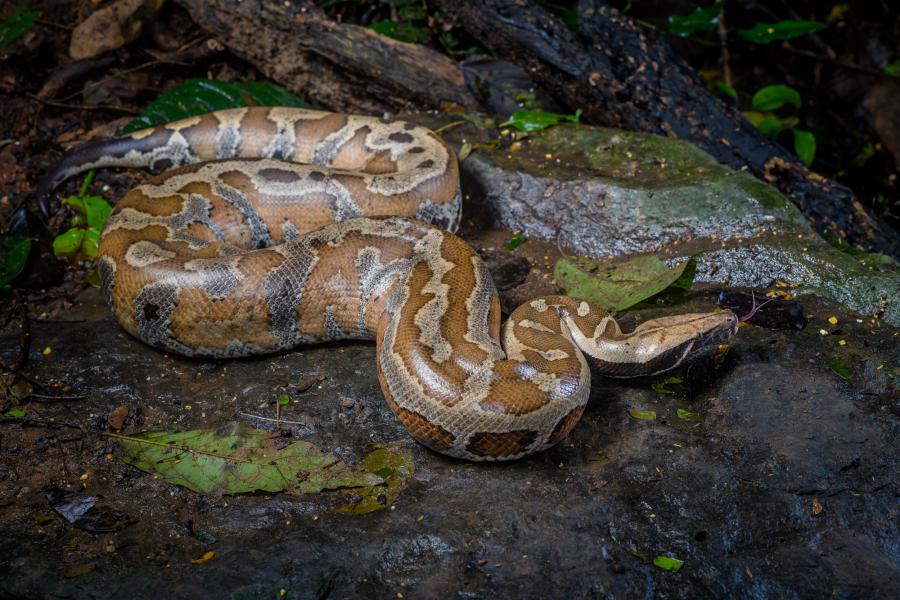
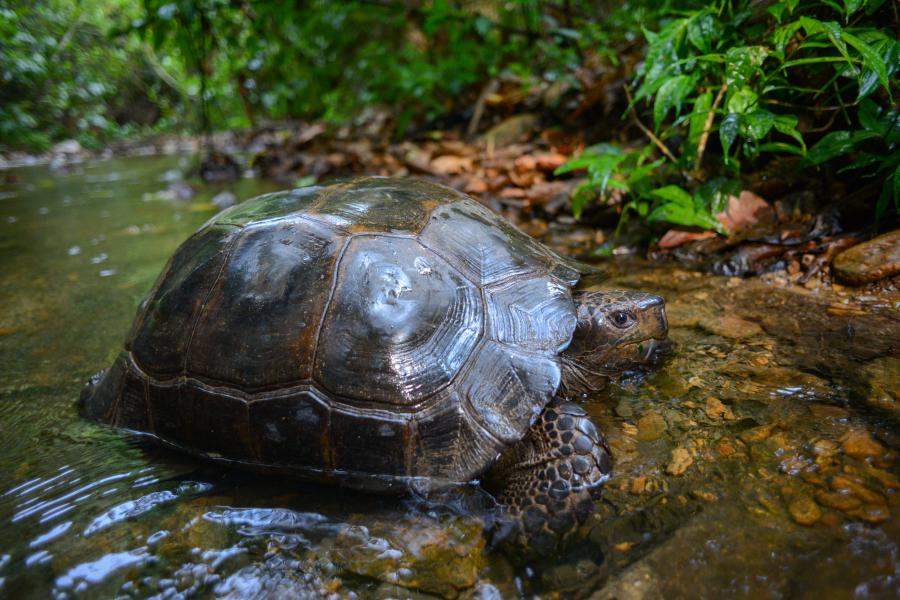

Clouded monitors are quite common in the park and can be seen nearly every day. They are often seen sunbathing on the road, crossing the road, in or around the ponds or sometimes crossing the camping ground at Ban Krang.
Butterflies
Kaeng Krachan is also one of the top butterfly watching destinations in the country. Around 300 butterfly species are found in the park.
It is possible to see hundreds and hundreds of butterflies gathered in small mineral rich spots. These spots are the camping ground, the road or the three river crossings west from Ban Krang. Butterflies are more active during the winter and dry seasons.

Visiting
Before getting to the park, it's good to know where you will be heading. Also good to know opening/closure times when deciding to stay overnight inside the park. We have often seen people arriving at the checkpoint too late to find out they can't enter the park.
There are no public transportation options into the central parts of the national park but it is possible to get to nearby Kaeng Krachan Town or to the park headquarters by minivan. The central part of the park is far from the town and the park headquarters. Private transportation needed to enter the park, the hotels in the area may arrange transportation.
Apart from studying the static map below for a quick overview, you are recommended to click the "open map" link from this page for a more detailed interactive map to have a good understanding about where the main attractions of the park are. The interactive map will also show some wildlife watching spots.
The real beauty of the park is in the central parts, around Ban Krang and Phanoen Thung campsites. Headquarters area is quite a dull place, it is only a campsite with a view over the lake.

Get to Kaeng Krachan Town and park headquarters
There are minivans operating from Bangkok and Phetchaburi and from there it is possible to change to a second minivan to Kaeng Krachan Town. For more info about the public transportation options, please visit our “Get There” section of the park.
Get to the campsites inside the park
There are no public transportation services to get into the heart of the park. The main campsites and wildlife watching areas are inside the park, far from Kaeng Krachan Town and the headquarters.
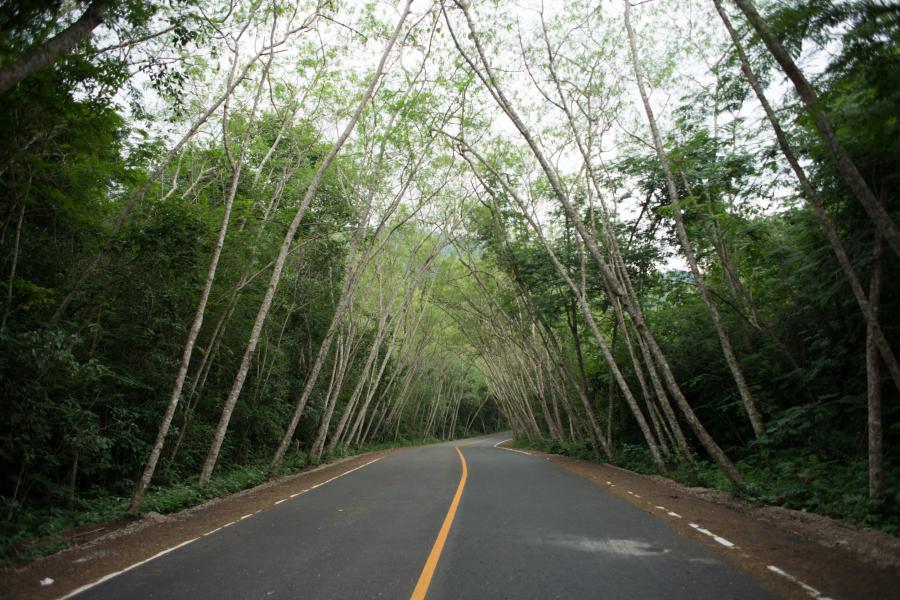
It is not possible to enter the central parts of the park by foot, bicycle or motorbike. For practical reasons, the best way to get to the park is with your own car, a guide or other private arrangements. Hitchhiking is possible but takes too much effort until reaching the campsites, mainly because of too many road turns and lack of enough traffic.
The entrance to the park is Khao Sam Yod Checkpoint, about 19 km west from the park headquarters. The “km zero” which is used as a reference point to various spots inside the park is a road junction 1.7 km before reaching this checkpoint. The kilometre reference is frequently used by park staff and frequent visitors. For example, Bang Krang Campsite is km 15, Phanoen Thung is km 30. These kilometer marks can be seen every one kilometer, the number will be on bigger black/white kilometer stones on the side of the road.
Ban Krang is the first campsite at km 15, around 320 meters asl. The road to Ban Krang is paved and in good condition.
Phanoen Thung is the second campsite at km 30, at around 950 meters asl. The bit of road west from Ban Krang until Phanoen Thung is a 15 km long, mostly steep dirt road.
Only pickups and SUVs with 4WD are allowed to drive up to Phanoen Thung Campsite, the cars should have high clearance. The road beyond Phanoen Thung Campsite extends another 6.5 km and ends at km 36.5 where a trail continues further west, branches to Thor Thip Waterfall and Phetchaburi River. This bit of the road after Phanoen Thung Campsite is officially closed for time being but the visitors are allowed to walk along the road.
It is possible to arrange transportation into the park once arriving at the headquarters. Following are the prices;
- Ban Krang, one way; 1,200 Baht
- Ban Krang, round trip; 1,400 Baht
- Phanoen Thung, one way; 1,800 Baht
- Phonoen Thung, round trip and out the next day; 2,500 Baht
For more detailed info about how to get to the campsite, visit the “Get There” section of the park.
Getting to Pala-u Waterfall
Pala-U Waterfall at the south edge of the park can easily be reached by any car or motorcycle. More info at the “Get There” section.
Getting around inside the park
The park is best to be explored with a car. It is possible to drive along the main road and stop at various spots for wildlife watching.
The visitors are allowed to walk along the dirt road west from Ban Krang Campsite for about 3.6 km. This bit of road will cross Pran Buri River 3 times until reaching a small dam at km 18.6. The road is popular mainly for birdwatching and butterflies. There are few side trails into the forest along this stretch of the road.
There are several short/medium long trails around Ban Krang and one short trail near Phanoen Thung Campsite. For info about these trails, please check the "Attractions" section further below.
Wildlife tours
For the first timers, no doubt the best way to explore the park is with a guide. It is possible to arrange wildlife tours with professional English speaking guides. Tours that can be booked via this website are;
- Birdwatching tours in Kaeng Krachan
- 1-day wildlife tour in Kaeng Krachan
- 2-days wildlife tour in Kaeng Krachan
- 3-days wildlife tour in Kaeng Krachan
Opening times
Sam Yot checkpoint (the main entrance into the park) is open from 5 am to 5 pm. The visitors inside the park are allowed to get out from the park until 7 pm.
The 15 km road between Ban Krang and Phanoen Thung is only open one way in a strict schedule;
- Heading up to Phanoen Thung; 5:00 am – 8:00 am
- Heading down from Phanoen Thung; 9 am – 11:30 am
- Heading up to Phanoen Thung; 1 pm – 3 pm
- Heading down from Phanoen Thung; 4pm - 5 pm
Pala-U Waterfall is open daily from 8:30 am to 4:30 pm.
While the main campsite Ban Krang and Pala-U Waterfall area will remain open all year round, the second major campsite Phanoen Thung will be closed from August to October every year.
Entrance fees
The entrance fees are 300 Baht for adults and 150 Baht for children 3-14 years old. Thai citizens pay 60 Baht for adults and 30 Baht for children. There will be an additional 30 Baht fee for vehicles and 30 Baht per night if you intend to camp.
Mobile reception & charging electronic devices
Mobile reception inside the park is very limited and to one provider only; AIS. It is only possible to get a signal in the immediate vicinity of the campsites. The cell towers are powered by batteries charged from solar panels. This means, during the cloudy days there may be interruptions in mobile reception. In the evening the campsites and the cell tower are powered with electric motors until around 8 to 9 pm.
It is possible to leave your electronic devices for charging at the restaurants in the early evening at your own risk. There won't be any power in day time.
Activities
The main activities in the park are camping, wildlife watching and hiking. Camping in one of the two campsites in the central parts of the park is a great experience. It makes it possible to see wildlife during the day and night, lucky visitors will wake up to the magical chattering of gibbons in the early morning which happens now and then.
Hiking
The trail options deep into the pristine forest are limited, but there are few good trails. Hiking must be accompanied by a ranger or a private guide as it is easy to get lost. Rangers can be hired on any of the campsites for a small fee on availability. Rangers can be hired from 400 Baht for shorter trails up to 3 hours. The price goes up for longer trails. It is not possible to book a ranger in advance.
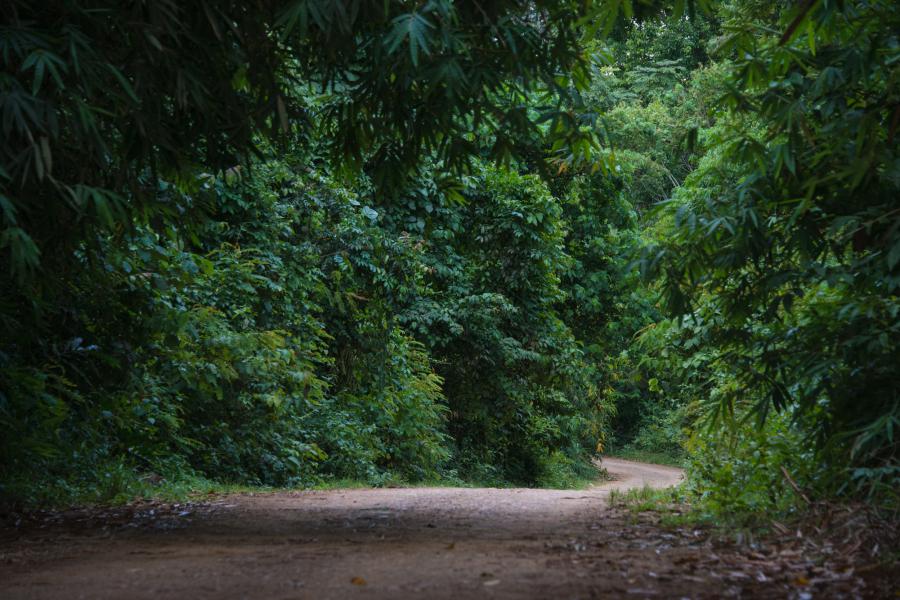
To see various trail options, open the interactive map from this page to see their location or scroll down to the “Attractions” section of this page for more info.
Sea of mist
During the winter months from November to February, sea of mist can be viewed from a couple of viewpoints around Phanoen Thung Campsite. The entire valleys around gets covered in white mist with only mountain tops sticking up, creating a peaceful view. The nearest viewpoint is just a few hundred meters walking distance from the camping ground, the second one is a few kilometres further west down the road.
Stay & eat
There are a good number of resorts outside the national park, most of them in Kaeng Krachan Town. Visitors that don't intend to camp inside the park are advised to do day trips from these resorts.
Camping
There are 4 campsites in Kaeng Krachan, of which two are at the central parts of the park, one at the headquarters area and one at Pala-U Waterfall checkpoint.
Tents and accessories can only be rented from the park headquarters near Kaeng Krachan Town. Tents cost 150 Baht (2 people) and 225 Baht (3 people) per night, accessories like sleeping bag, mat, pillow cost 10 to 30 Baht each. Tents can be taken into the national park in person and to be returned to the headquarters on the way out. If you have your own tent, it will cost 30 Baht per night to use the camping ground.
Park rangers at both campsites inside the park also have their own tents to rent, but at an unknown price, much higher than tent prices provided from the headquarters. A typical price is around 400 Baht.
During the week-ends the campsites may get busier by local tourists but often not really of a crowded level. During the weekdays from Monday to Friday only a few tents are seen around. The campsites will get extremely crowded during longer holidays for sure.
For more info about each one of the campsites, scroll down to the “attractions” sections of this page.
Park accommodations
There are no accommodations in the central parts of the park. There are a number of rooms near the headquarters; 4 people options are 1,500 Baht per night, one single chalet for 10 people is 3,000 Baht. 30% discount will apply when booked for Monday to Thursday.
The accommodations can only be booked through the DNP website in advance. As the money transfer must be done within 2 days and the fact that it takes a longer time with transfer from abroad, it is only possible to book from within Thailand. Payments can be done at 7-Eleven convenience stores or banks.
There are also some rooms available near the Pala-U Waterfall checkpoint, next to it’s camping ground. These too can be booked via the DNP website.
Baan Maka Nature Lodge
A popular hotel with both naturalists and those looking for a quiet break away from general tourism. Located between Kaeng Krachan town and the national park entrance, the hotel is well situated for the park and the local bird watching hides. The lodge grounds are extensive and home to a large range of wildlife. The staff help with booking hides, local transport and other services, the owners are keen naturalists who can help you with planning and identify anything you have seen. There is a restaurant on-site open from 5:30 am to 9 pm to cater for those spending the day in the park.
Eat
There are basic restaurants at both campsites inside the park and headquarters, but none at Pala-u Waterfall. If there are not enough visitors around, the restaurant at Ban Krang may be closed some days during the week-days Mon to Fri, but will be open during the week-ends. It is good to assume both restaurants will be closed during the week-days, if you intend to camp, good to take your own food and cooking set with you.
Kaeng Krachan on Facebook
If you have questions regarding Kaeng Krachan National Park you can't find answers for or would like to share your photos/experience, feel free to join our Kaeng Krachan group on Facebook.
Phone(s)
You are recommended to ask a Thai speaking person to call on your behalf.
- Visitor Centre: Tel: +66 (0) 32 772 311
- Park Headquarters: +66 (0) 32 459 293
Attractions of Kaeng Krachan
Ban Krang Campsite
If not the very best, the area around Ban Krang Camp is one of the best places in Thailand for watching rare birds and butterflies.
There are two camping grounds at Ban Krang, one is next to the Pran Buri River along the main road right at the entrance, the other one is just a couple of hundred meters uphill behind the visitor center.
There is a restaurant and two sets of toilet/shower facilities within the main camping ground area. The upper camping ground also has toilets/showers.
Tents and sleeping sets can be rented from the headquarters outside the park, near Kaeng Krachan Town. Some rangers may have their own tents to rent for an unknown price, typically around 400 Baht.
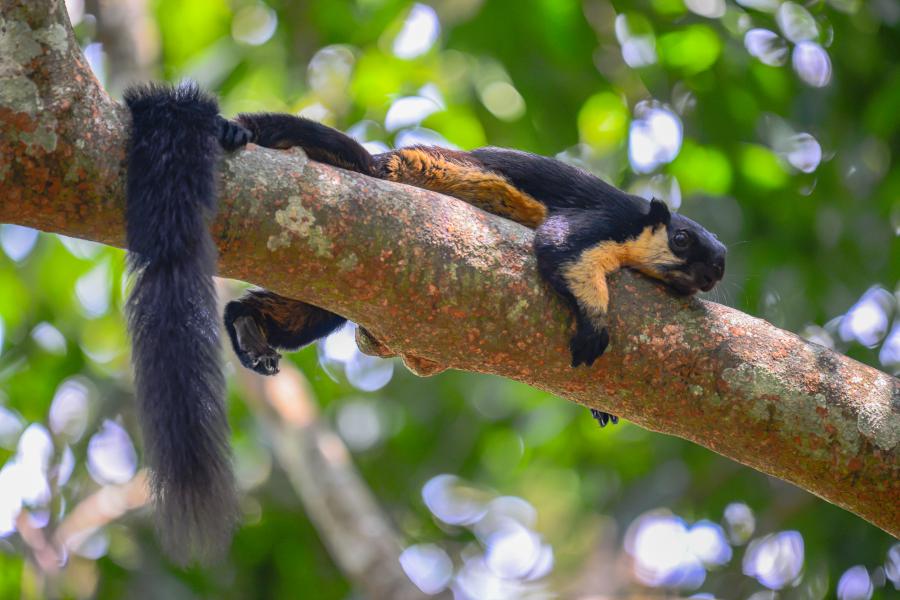
Along the road east and west from the campsite there are several butterfly and bird watching spots and a number of trails into the forest.
The restaurant is often closed during the week-days but open 6 am until 5 pm during the week-ends. The food at the restaurant is very basic. The campers are recommended to take their own food and cooking set with them.
Hua Chang Cave
A cave located 2 km east of Ban Krang Campsite, accessible by a nearly 500 meters long trail. Hua Chang means 'elephant head', referring to a formation that is said to be resembling an elephant head. The cave has a big rocky opening, two bigger and a few tiny small chambers. The cave is around 70 meters in length.
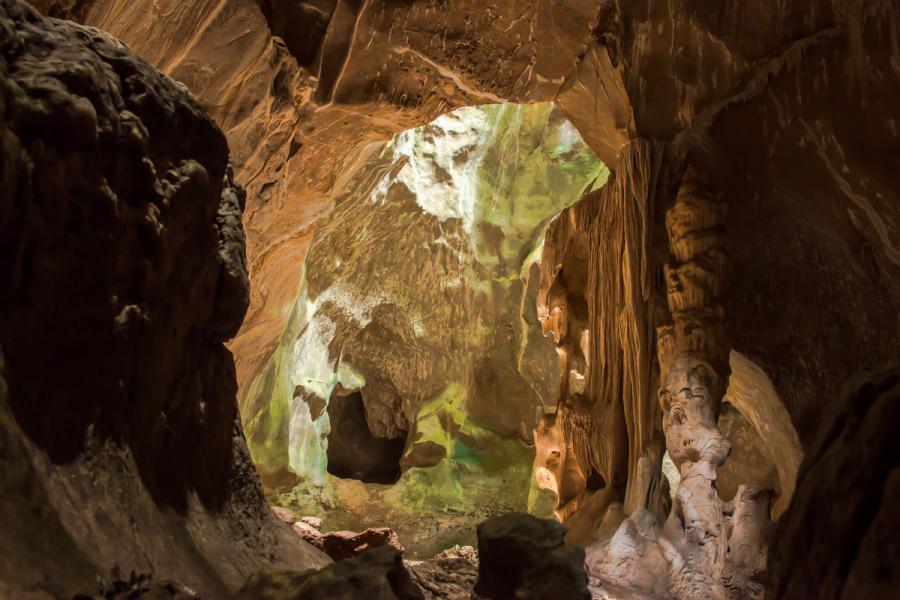
The trail to the cave branches off at a few spots. It is best to get there with a ranger otherwise there is a good chance of getting lost.
Khao Pakarang Caves
Twin caves only a few hundred meters from each other, reached from the “Khao Pakarang” dirt road approximately 3.5 km south from Ban Krang Campsite. The trail to the caves is only a couple of hundred meters after the second river crossing on the left side (not to be confused with the classic river crossings to the west from the campsite).
The trail to the first cave is moderate to difficult, but the second cave is very hard and almost requires climbing skills.
Horseshoe bats can be found in both caves. The first cave has an additional chamber, the second cave has a single big chamber. Flashlight is necessary to find eventual cave racers hunting bats but also to see some smaller chambers a bit into the caves.
Visitors must be accompanied by a ranger to walk the dirt road or walk up to the caves. Rangers can be hired for around 400-500 Baht on availability for around 4 hours.
Phanoen Thung Campsite
Phanoen Thung Campsite is 950 meters asl, 15 km further west from Ban Krang Campsite, 28 km from Dan Khao Sam Yot Checkpoint and 49 km from the park headquarters. The bit of road from Ban Krang is dirt road, only accessible with stronger terrain vehicles.
There is a restaurant, visitor center and toilets/showers facilities around the campsite. Tents and sleeping sets can be rented from the headquarters outside the park, near Kaeng Krachan Town. Some rangers may have their own tents to rent for an unknown price, typically around 400 Baht.
The restaurant tends to close around 5 to 6 pm.

Phanoen Thung is very popular for its view of the sea of mist, viewpoints and birdwatching spots. The area around is ideal for watching highland birds such as hawks, eagles and many others. It is the only place in Thailand where ratchet-tailed treepie known to be found.
Yellow-throated martens and Malayan porcupines seen often around the campsite, wild boars occasionally may visit the restaurant for food rests. Not a common sighting, but it happens now and then that people see clouded leopards along the road, a few kilometres east and west from the campsite. Sun bears are also seen from time to time.
There is a small circular nature trail through some nice forest habitat a few hundred meters east from the campsite. It is a good place to find the southern variation of Pope’s pit viper.
There are no official longer trails around the campsite. There is an approximately 8 km long trail to Khao Phanoen Thung peak, but it hasn't been maintained for a while and closed for the time being. This peak was accessible by a day’s hiking, normally requiring a night’s stay at the top with a ranger with a strict permission from the headquarters.
Phanoen Thung viewpoints
There are three viewpoints in the immediate vicinity of the camping ground, only a few hundred meters apart from each other. The main viewpoint is a few hundred meters west, looks out towards Tanaosri Range on Myanmar's border and has a magnificent view. The other two viewpoints are next to the restaurant and in the camping ground.
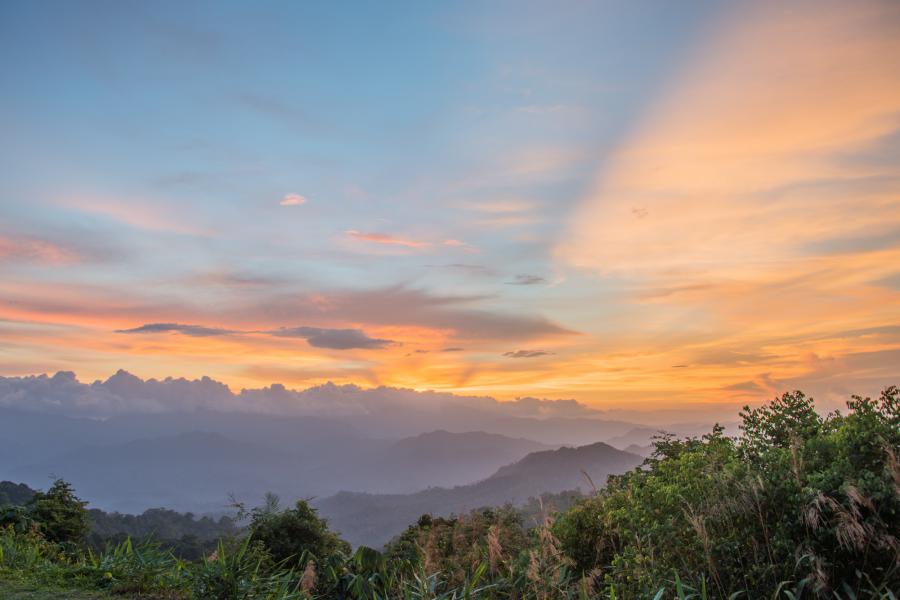
There are two more viewpoints along the road further west of which one a couple of kilometres from the campsite, the other one not too far from the end of the road. Open the map to see their locations.
Royal residence
Located 700 meters northwest from the campsite, His Majesty King Bhumibol Adulyadej stayed in this place when he visited the national park a few times in the past. The flag raised on the hill can be seen from the campsite. The area has great views in most directions.
A third of the way uphill there is a big tree on the left side where the very rare ratchet-tailed treepie may be seen from time to time.
To get to the residence, walk west for 400 meters, turn right, walk around the barrier and continue uphill.
Khao Phanoen Thung Peak
With 1,207 meters asl, Khao Phanoen Thung is the second highest peak in the national park. It has a great view and is accessible by an 8 km long trail. Unfortunately, the trail is closed for the time being.
HQ Campsite
A spacious campsite along the lake next to the park headquarters, about 6 km from Kaeng Krachan Town center. Tents are available for rent from the visitor center. There are several clean toilet and shower facilities, a restaurant, a smaller kiosk and an ATM in the vicinity. The visitor center and the restaurant offer free WiFi, mobile reception is good in the area.
Unless arrived too late to enter the central parts of the park, the visitors are not recommended to stay in this campsite. Ban Krang and Phanoen Thung campsites are better options.
Bird species such as hornbills, kingfishers, herons, egrets and many others can be found in the vicinity of the campsite.
Kaeng Krachan Dam
Holding the reservoir within Kaeng Krachan National Park. The dam is outside the park, 4 km north of the HQ. There are few islets in the reservoir and the lake is suitable for a number of water activities. There is a viewpoint on the top of the dam barrier with a good view of the lake and the town.
Trails
Although most of them are quite short, there are a good number of trails that can be walked around Ban Krang Campsite.
The main trail is the 2 km long one, referred to as “Pranburi Trail'' or “Nature Trail''. The trail starts from the far end of Ban Krang Campsite, follows the stream and the main road and ends right after the first stream crossing west. The trail is quite clear and signposted well. It is not easy to get lost as one side of the trail is a steep mountain slope while the other side is a stream and the road. Once reaching the first stream crossing, the hikers can either continue further west to other trails or walk back to the campsite on the main road.
At the first stream crossing there is a 650 meters long circular trail that ends at the second stream crossing. Further west from the 2nd stream crossing there is yet another 660 meters long circular trail that ends only 40-50 meters from it's trailhead along the road.
Further west at km 18, next to the dam, right after the road barrier to Phanoen Thung Campsite, there is a very long trail to Pranburi Waterfall. This trail must be accompanied by a ranger or a guide. The trail is through lush habitat, a great place for mammals, tapir footprints have been seen along this trail.
Around 100 meters down the dirt road south from Ban Krang Campsite the 1.5 long and circular Vanilla Nature Trail starts. This trail crosses the Pranburi River stream and reaches the Sapria ram flower (a flower in Rafflesiaceae family) habitat and ends at the main road east from the campsite.
A recently (2018) opened trail starts near the entrance of the upper campground at Ban Krang. This trail is 2 km long and ends 650 meters east from the camping ground on the main road at the opposite side from the Vanilla Trail. Visitors should never walk this trail on their own as there are a series of clear side trails, very easy to lose orientation and get lost. Elephants and bears are seen in this area, even claw marking after bigger cats (likely leopards) seen on the trees. Once reached the road, it is possible to enter the Rafflesia trail (Vanilla Trail) back to the campsite for a longer hike.
There is another new trail opened from Ban Krang Campsite earlier in 2019. We haven’t mapped this trail yet. The trail is difficult to walk, quite steep up to a mountain and ends at an abandoned ranger station. More info about this trail to follow once we explored it.
The only trail up at Phanoen Thung Campsite is a very short nature trail just a few hundred meters before reaching the campsite. This trail is a great place to find the southern variation of Pope’s pit viper which possibly will get split to a new species.
At the end of the road (km 36.5) there is a series of trails that reaches Thor Thip Waterfall and the Phetchaburi River. These trails must be walked with a ranger or a guide, it is easy to lose the orientation and get into wrong side trails without guidance.
Ponds & saltlicks
There are many artificial ponds in the park, most of them along the main road from around km 9 until Ban Krang Campsite. Some ponds are not seen from the road, accessible by a short stroll into the forest.
The ponds get filled with water during the rainy seasons and become an important water source for animals during the dry season until they eventually dry out.

Animals seen around the ponds are; king fishers and clouded monitors are very common, sambar deer and reticulated pythons are the next relatively common sightings but it doesn’t mean they can be seen easily. Elephants, gaurs, leopards, dholes, Asian golden jackals, king cobras are seen around these ponds from time to time, some very rare. Sometimes turtles can also be seen in the ponds.
There are several saltlicks around up to 4-5 km east from Ban Krang. Gaurs, elephants and deer are seen visiting these saltlicks from time to time.
Thor Thip Waterfall & Trail
Important info - Thor Thip Waterfall is closed until further notice.
A 9-tiered waterfall along the Phetchaburi River accessible by a 2.4 km long moderate/difficult trail. The trailhead is at the end of the dirt road 6.5 km west from Phanoen Thung Campsite. Most of the trail is easy to moderate to walk but the last few hundred meters of the trail down to the waterfall is very steep, difficult to walk and very slippery when wet.
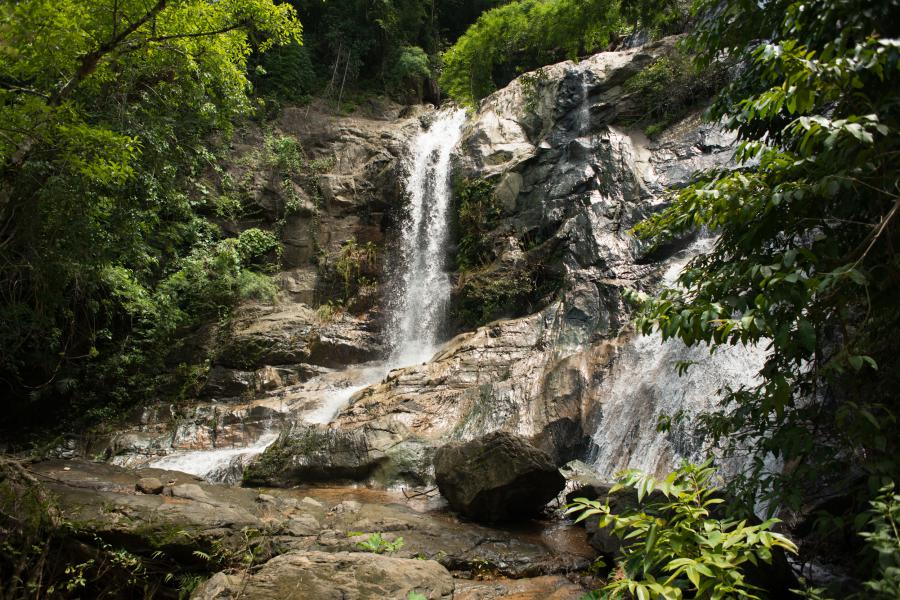
Although it is a multi-tiered waterfall, only one tier can easily be reached. When getting there, chances that someone else will be there is minimal. Water flows down on the rocks nearly vertically and streams down to a couple of ponds. It is an excellent place to relax and swim, the view of the forest around is excellent.
The area around is as far into the park visitors can get in.
A side trail continues another 1.5 km west, passing one of the tiers of Thor Thip and continues all the way to Phetchaburi river.
Pran Buri Waterfall & Trail
A small waterfall accessible by a moderate to difficult hike. The trailhead is near the small dam 3.6 km west from Ban Krang Campsite. Since only getting forward and backward to the trailhead will be over 7 km, it is wise to get to the small dam with a car and start hiking from there. The trail itself is about 3-4 km long, it follows the stream all the way to the falls.
There are two other smaller waterfalls down and upstreams from the waterfall. Last kilometre of this trail is more difficult to walk. The trail often is covered with overgrown bushes, fallen bamboo or trees, not easily accessible. The smaller fall upstream is quite difficult to reach. A ranger or guide needed to walk this trail.
The valley along the trail is quite lush most of the year, an interesting place to find many animals. The area is known to be bear habitat, tapir footprints and dung has also been seen.
Pala-U Waterfall
A 16 tiered waterfall falls at the southwest edge of the national park, easily accessible from Hua Hin area by route 3219. The checkpoint, visitor center and the camping ground is 4.5 km before reaching the falls.
The tiers are not too high but all accessible by a rocky path. The main activity is to swim in one of the many ponds or walk the rocky path of the falls for kilometres into the forest.
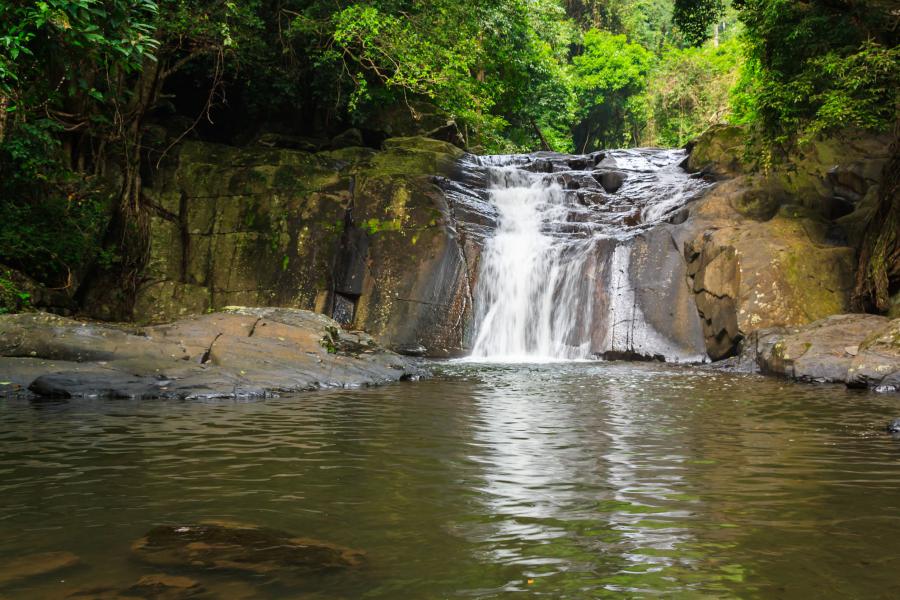
For the campers, tents and accessories are available for rent from the visitor center. There are no restaurants near the falls or the campsite. The nearest restaurants are in Huai Sad Yai village 12 km east.
There is no mobile reception around Pala-U Falls, nor any reception at it’s checkpoint and the camping ground.
The waterfall is open from 8:30 am to 4:30 pm every day, all year round.
The road along the national park edges to Pala-U Waterfall around Huai Sad Yai Village is a dense elephant habitat. Elephants along the road are quite a common sighting, elephants tend to often visit the village, even creating problems for the shops and the local market. Due to elephant-human conflict, now and then dead elephants found nearby fields, sometimes electrocuted by illegal electric fences, sometimes with gunshots. Every couple of years some villagers are also killed by an elephant in the area, often around the fields.
Where to go next?
If you need ideas where to get next after visiting Kaeng Krachan, a few options;
Near Bangkok
Khao Yai National Park; located in the opposite direction from Bangkok. It is one of the best national parks in the country with best possibility to see some impressive wildlife.
Near Hua Hin
Kui Buri National Park; nearly 95% chance you will see wild elephants any given day of the year. Other common mammals; deer, golden jackal, Burmese hare and gaur.
Khao Sam Roi Yot National Park; to see Phraya Nakhon Cave, few other caves, freshwater march with very impressive view of limestone mountains, viewpoint, boat tour in canal.
Near Phetchaburi
Visit WFFT; to see rescued wild animals, rehabilitation facilities and attend a tour. Here you will find number of permanent resident animals, and others waiting to be released to the wild. Animals like elephants, primates, slow loris and many more, hundreds of them.
Near Kanchanaburi
Erawan National Park; it is the most popular waterfall in the country for the foreign tourists.
South Thailand
Khao Sok National Park & Cheow Lan Lake; It is the most popular inland national park in South Thailand, very popular for it's floating raft houses in Cheow Lan Lake. Near Phuket, Khao Lak, Ao Nang, Krabi, Surat Thani and Ko Samui.
